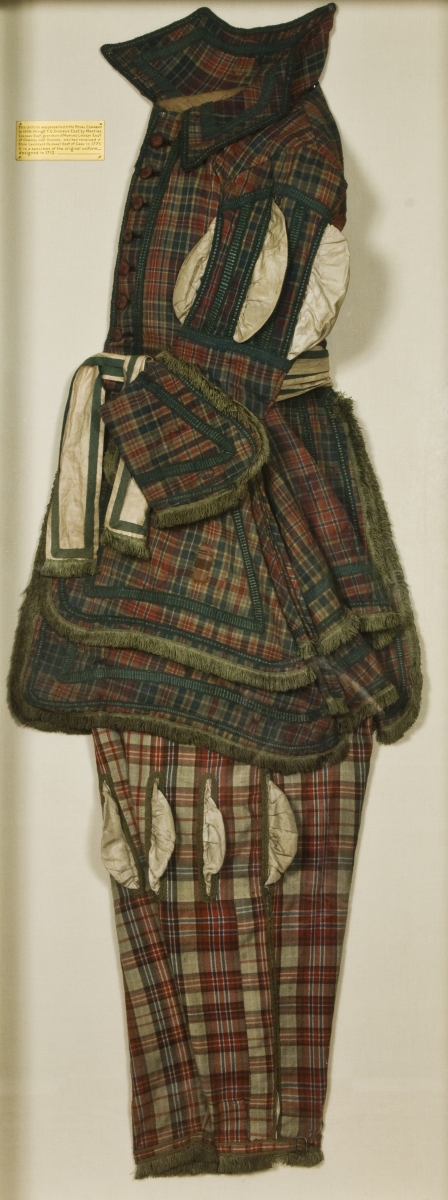 |
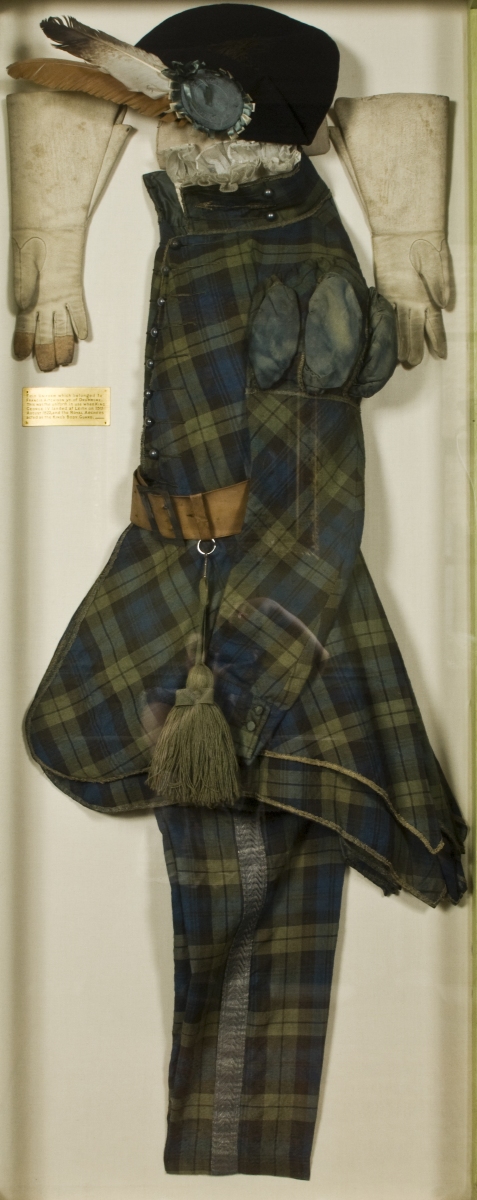 |
| This uniform was presented to the Royal Company in 1856, through TG Dickson Esq, by Martine Lindsay, grandson of Martine Lindsay Esq of Dowhill near Dundee, who had received it from Laurence Oliphant Esq of Gask in 1777. It is a specimen of the original uniform, designed in 1713. |
Field Uniform which belonged to Francis Aitchison yr of Drummore. This was the uniform in use when King George IV landed at Leith on 15th August 1822 and the Royal Archers acted as the King’s Body Guard. |
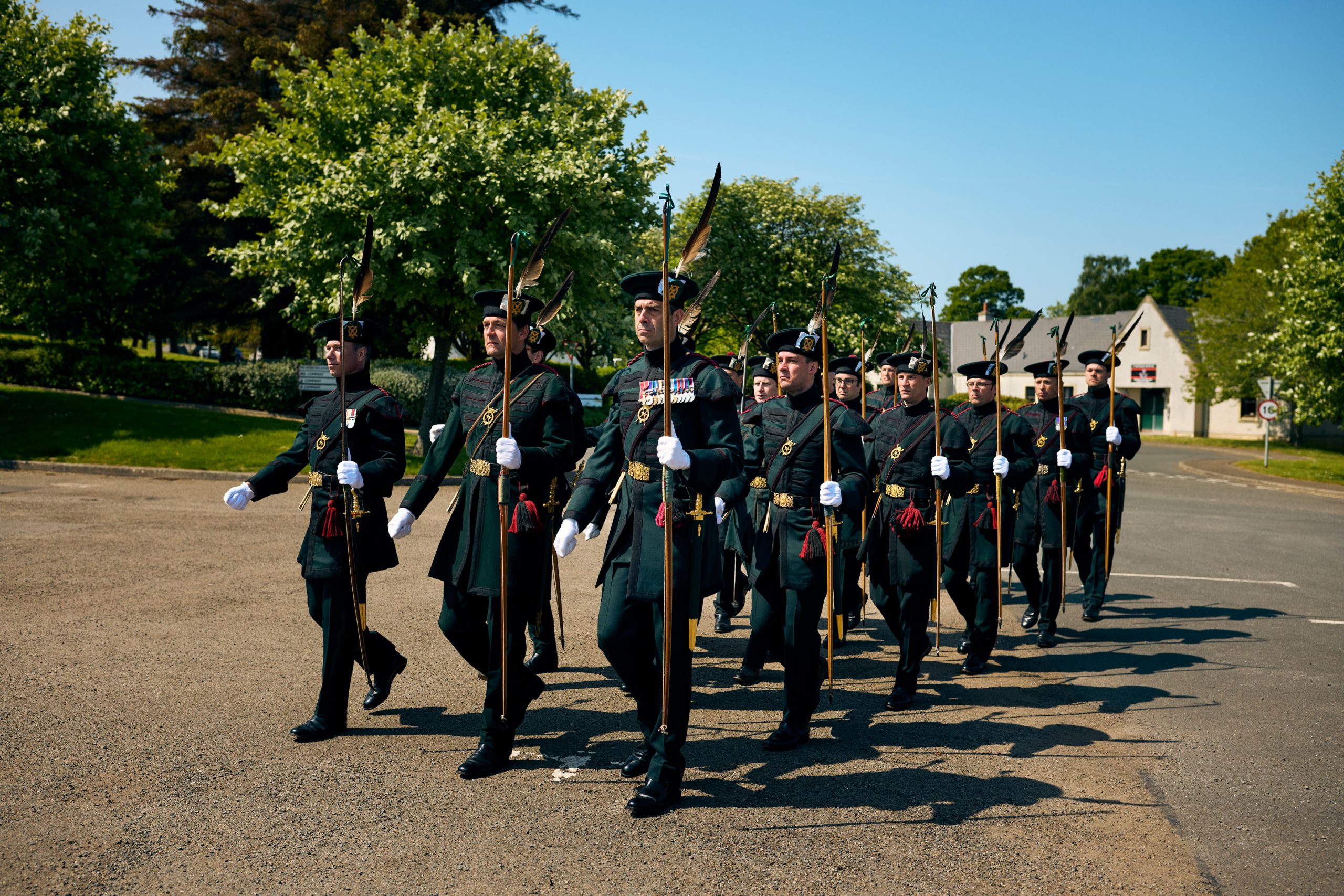 |
Unchanged since 1863, this section provides a description of the uniform now worn on ceremonial occasions by The Royal Company. Images of the various badges are at the end of the section.
For information about the Bow itself, please see Archery. On ceremonial occasions the bow string is secured to the front of the bow with a discreet piece of tape.
History
Uniform was first mentioned at a meeting of the Council on 16 August 1676 when the Treasurer was ordered to provide the newly appointed drummer to the Company, Alexander Strachan,,
‘. . . a Coat of green colour, with a white sash to wear about his weast, and a buss of white Ribbans on his shoulder, and a green Smal Staff which he is to wear upon all publick occasions, or when he is ordered to warn the Archers to meet. And the said Staff is to have on the top thereof the King’s Arms and the Company’s Seall.’
There have been a number of versions of the Field Uniform of The Royal Company over the centuries but today’s version is unchanged since 1863. As one historian of The Royal Company (1951) put it, ‘The Royal Archer of the seventeenth and eighteenth centuries was a much more dressy individual than his soberly-clad equivalent of today’.
|
The Uniform Since 1863
Although the style of the Crowns and the title (either the King’s or the Queen’s Body Guard for Scotland), that the uniform is unchanged since 1863 is perhaps more due to economy than anything else. This, wrote the Royal Company’s historian of 1951, ‘was greatly assisted by the avowed anxiety of King George V to cut down unnecessary expenditure and display in the increasingly difficult days of financial stringency following the industrial and economic slump of 1931 . . . by 1945 such economies had become automatic and self-operating.’
Field uniform is now worn on all ceremonial occasions. However, the Captain-General, uniquely, wears the old Court Dress of The Royal Company.
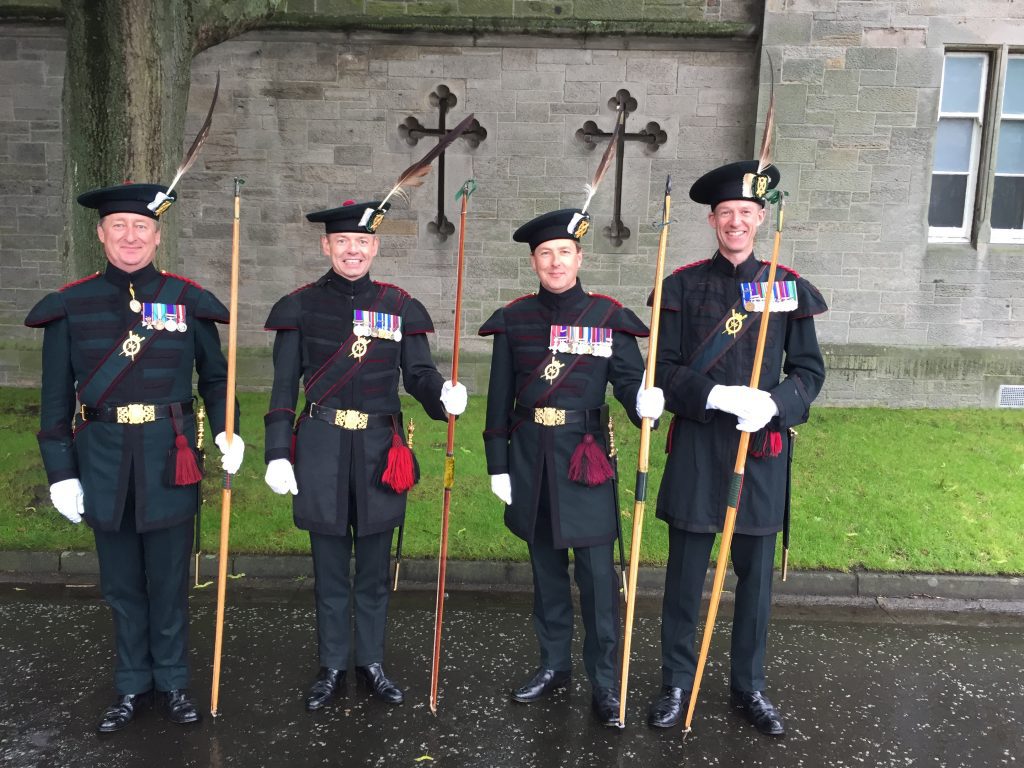 Archers at ease, July 2017 Archers at ease, July 2017 |
Archers
The headdress is a stiffened bonnet of green with a crimson toorie and black mohair headband. The bonnet badge is of crossed arrows, with the inscription ‘Royal Compy of Archers’, on a green and white cockade and worn with a single eagle’s feather. The cockade has been worn since 1713.
The tunic is green laced with black mohair with crimson lights. Twisted crimson cord epaulettes adorn the tunic shoulders. The trousers are green and tightly-cut. A double black line of mohair with a crimson light runs down the outside of the leg.
The leather-backed bow-case is of green and bound with black mohair trimmed with crimson. On the centre of the bow-case, which is aligned with the centre of the chest, is a badge of crossed arrows with the Company’s motto of 1676, ‘In Peace and War.’ The bow-case is worn across the left shoulder descending to below the right hip and is secured there by a brass Star of The Thistle (the old bonnet badge prior to 1863). The bow-case is held in place by a black patent-leather belt with an ornate brass buckle on which is displayed the Royal Crest of Scotland. From this belt hang, on the left-hand side and to the front, a red and black woollen tassel which was originally used for cleaning arrows. The short brass Roman-style sword in its black frog and scabbard is suspended from the left hip.
When ordered, a ‘pair’ arrows (which, in fact, are three arrows) is worn tucked under the belt under the right arm with the points foremost and downwards. Black George boots are worn.
|
Officers
The dress for Officers is almost identical but for the addition of gold piping to the crimson light. A twisted gold cord epaulette replaces the twisted crimson cord epaulettes worn by Archers. Officers carry a long sword with a cross hilt and two eagles’ feathers are worn in the bonnet and wear collar-badges to denote their rank. The Captain-General wears three eagles’ feathers. The Adjutant wears gold spurs.
The Secretary, Treasurer and Surgeon carry Officers’ swords without the Officers’ gold lace. The Secretary, Treasurer and Judges wear specific collar badges. The Secretary wears the feather of a condor in his bonnet. This was presented by the Earl of Dalhousie around 1830-32 when he was both Captain-General (1830-38) and Commander-in-Chief of India (1830-32).
All Ranks wear white gloves. Sashes, orders, decorations, medals and medal ribbons are worn in the manner prescribed in Army Dress Regulations in accordance with The Queen’s Regulations for The Army (2010). Shooting medals of The Royal Company of Archers with clasps are also worn by those so qualified when not on Body Guard duties.
Shooting Parades
For shooting parades, the normal Field Uniform is worn but with a softer version of the bonnet and, for the duration of the shoot, the left cuff of the tunic may be removed.
The Badges
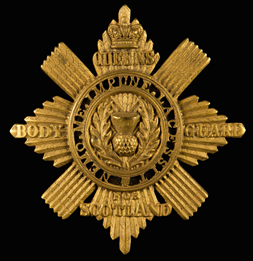 |
The Star of The Thistle
Worn at the bottom of the Bow-case, the Star is that of the Order of The Most Noble Order of the Thistle. It consists of a St Andrew’s saltire with clusters of rays between the arms thereof. In the centre is depicted a circle bearing the motto of the Order in gold; within the circle, there is depicted a thistle on a gold field. Superimposed on the badge is the Royal Crown and depending on reign in which the badge was made, either ‘QUEENS BODY GUARD FOR SCOTLAND’ or ‘KING’S BODY GUARD FOR SCOTLAND’
‘Nemo me impune lacessit’ (No one provokes me with impunity) was the Latin motto of the House of Stuart, dating from the reign of King James VI. It roughly translates in Scots as ‘Wha daur meddle wi’ me’. In addition to the Most Ancient and Most Noble Order of The Thistle, it is also the motto of the Royal Scots Dragoon Guards, the Scots Guards and the Royal Regiment of Scotland.’
|
|
|
The Bonnet Badge
The Cross of St Andrew on which two arrows and the Royal Crown are superimposed within a circle bearing the title ‘ROYAL COMPY OF ARCHERS.’ Below is an emblem of the Thistle within a circle with the motto ‘NEMO ME IMPUNE LACESSIT’, a motto of The Royal Company and displayed on the Colours since 1713, following the grant of a Royal Charter by Queen Anne in 1704.
|
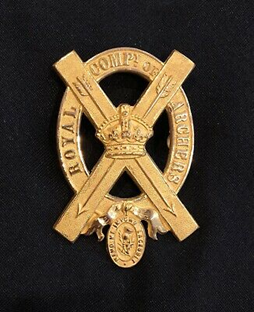 |
|
|
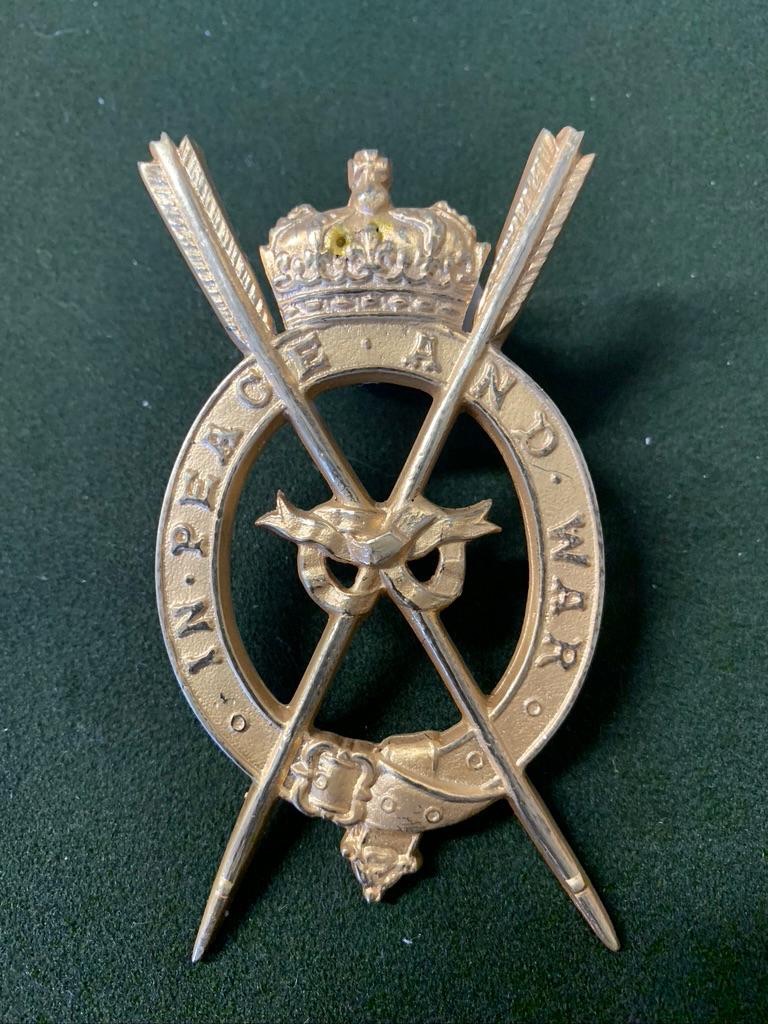 |
The Bow-Case Badge
1676. The Bow-Case badge is of crossed arrows and bears a Royal Company motto ‘In Peace and War’. This motto is derived from the Fourth (Quarto) Law of the Royal Company (1676): ‘. . . which Act shall have appended to it the Company’s Seal, bearing for their Arms, Cupid and Mars, with the motto, ‘IN PEACE AND WARR.’
|
| |
|
The Belt Buckle
At the centre of the brass buckle is a crest and the motto ‘IN DEFENS.’ The crest, atop the Crown of Scotland, is a lion, seated and forward facing, itself wearing the Crown of Scotland and holding the two remaining elements of the Honours of Scotland, the Sword of State and the Sceptre. ‘IN DEFENS’ is the abbreviated form of ‘In my defens God me defend’, in use since 1488 (if not earlier), the motto of both the Royal Coat of Arms of the Kingdom of Scotland and the Royal Coat of Arms of the United Kingdom used in Scotland
The badge is inscribed with either ‘QUEENS BODY GUARD FOR SCOTLAND’ or ‘KING’S BODY GUARD FOR SCOTLAND’ depending on reign in which the badge was made,
|
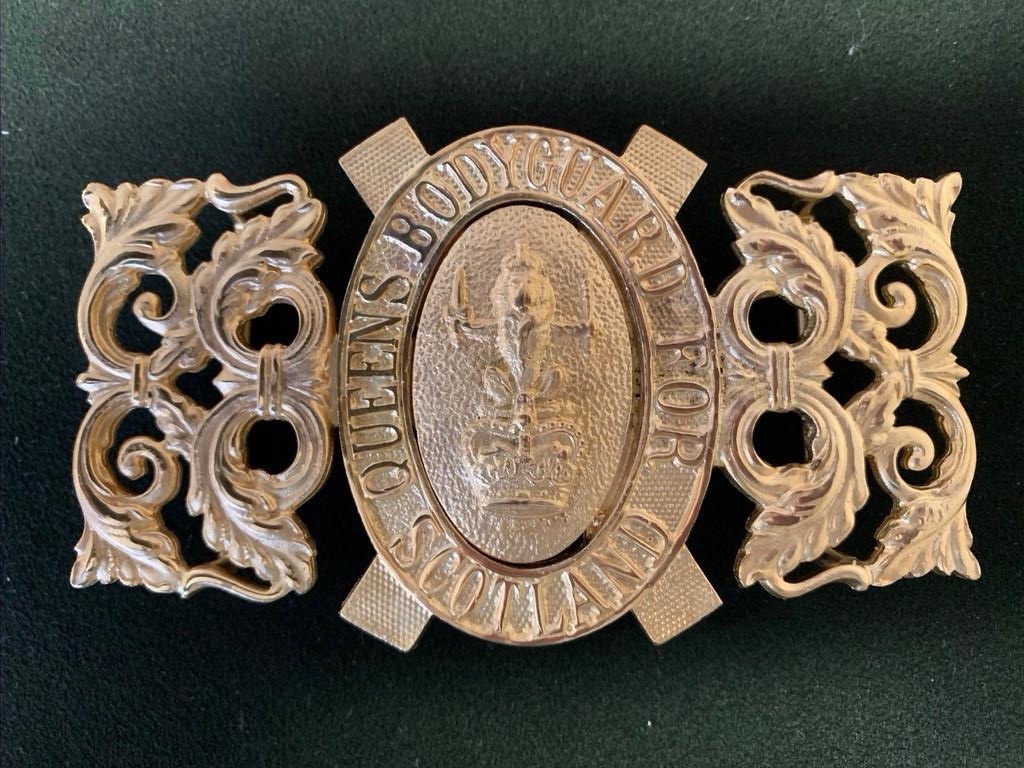 |








